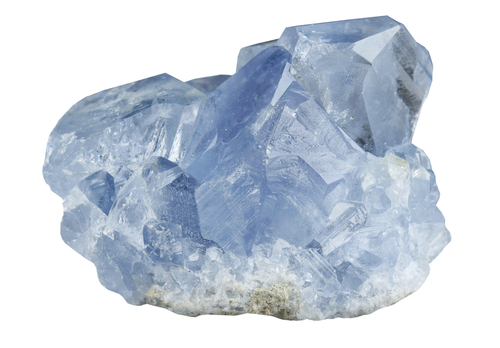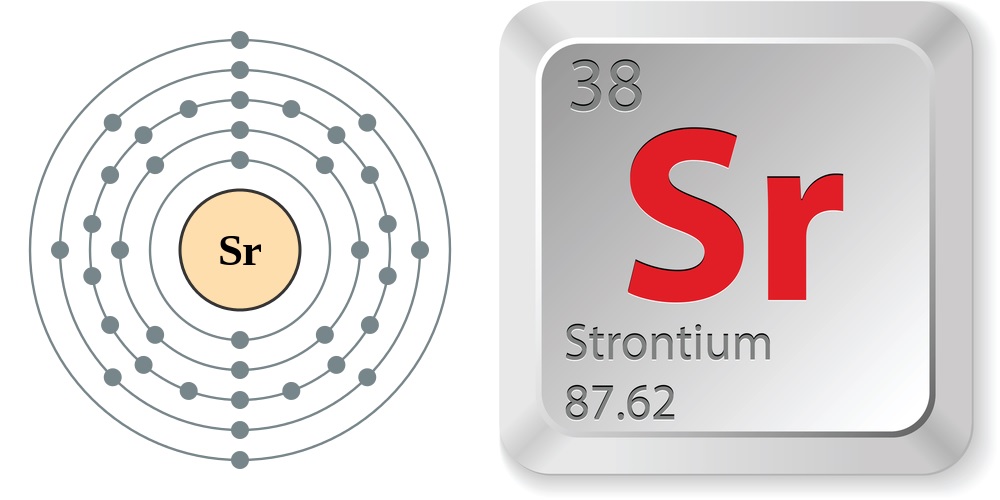Facts About Strontium

Strontium is a soft, silvery metal with a number of uses: It blocks X-rays emitted by TV picture tubes; it causes paint to glow in the dark; and it is responsible for the brilliant reds in fireworks. Strontium also plays an important role in figuring out the origins of species: Anthropologists measure the levels of strontium ions in bones and teeth to help determine the geographic origins of ancient humans and animals. While natural strontium is harmless, one of its isotopes, Sr-90, carries a more sinister reputation: It is a dangerous byproduct of nuclear fallout.
Highly reactive
Strontium is quite common in nature — it is the 15th most abundant element in Earth's crust, according to the Minerals Education Coalition (MEC). Strontium occurs in about 0.03 percent of all igneous rock, according to the US Geological Survey (USGS). Natural strontium is a mixture of four stable isotopes — Sr-84, Sr-86, Sr-87 and Sr-88 — and is primarily found within the minerals celestite and strontianite.
Like other alkaline-earth metals, strontium is highly reactive chemically and reacts with both air and water. When exposed to air, it burns with a bright red flame. When combined with water, strontium gives off hydrogen gas and strontium hydroxide — a strong irritant.
While natural strontium is stable and not hazardous to health, the synthetic Sr-90 isotope is radioactive and a dangerous component of nuclear fallout.
World resources of strontium are thought to exceed 1 billion tons, according to the USGS. The primary producers of strontium as celestine are China and Spain, followed by Mexico, Argentina and Morocco. Although strontium deposits occur widely in the United States, they have not been mined since 1959.
Just the facts
- Atomic number (number of protons in the nucleus): 38
- Atomic symbol (on the periodic table of the elements): Sr
- Atomic weight (average mass of the atom): 87.62
- Density: 2.64 grams per cubic centimeter
- Phase at room temperature: Solid
- Melting point: 1,431 degrees Fahrenheit (777 degrees Celsius)
- Boiling point: 2,520 degrees F (1,382 degrees C)
- Number of isotopes (atoms of the same element with a different number of neutrons): 28 whose half-lives are known; 4 stable
- Most common isotopes: Sr-88 (82.58 percent natural abundance); Sr-86 (9.86 percent); Sr-87 (7 percent); Sr-84 (0.56 percent)
Uses
Finely powdered strontium metal will ignite spontaneously at room temperature. If you've ever shot off a red firework or road flare or used glow-in-the-dark paint, you were most likely witnessing strontium carbonate in action. These strontium salts give off a brilliant red color and are also used to stabilize firework mixtures, according to Thought Co.
Another primary use for strontium is in glass for color television cathode ray tubes (CRTs) where it is used to prevent X-ray emission. This use is rapidly declining, however, as CRTs are being replaced due to advances in flat-panel technologies, which require smaller amounts of strontium carbonate. This has had a significant impact on strontium mining and refining, according to the USGS.
Get the world’s most fascinating discoveries delivered straight to your inbox.
Strontium is also used in ferrite magnets (iron oxide combined with one of more metallic elements) or in zinc refining processes. The element can also generate electricity for space vehicles, remote weather stations and navigation buoys. Strontium chloride hexahydrate is an ingredient in toothpaste for sensitive teeth, according to the Royal Society of Chemistry (RSC).
Discovery
In 1787, an unusual rock was discovered in a lead mine in the Scottish village of Strontian and brought to Edinburgh for inspection. There it was analyzed by Irish chemist and physician Adair Crawford. While some believed it to be a type of barium compound, Crawford soon discovered it was a new mineral containing an unknown substance that he named strontia, after the village, according to RSC.
In 1791, Edinburgh chemist Thomas Charles Hope produced a number of compounds with strontium, also noting that it caused the candle's flame to burn red — unlike barium compounds that gave off a green color, according to RSC. Meanwhile German chemist Martin Heinrich Klaproth was also performing tests on the new mineral and managed to produce both strontium oxide and strontium hydroxide.
In 1808, at the Royal Institution in London, Cornish chemist and inventor Humphry Davy isolated strontium metal by means of electrolysis, using the method by which he had already isolated sodium and potassium, according to RSC.
Strontium dating
Most strontium is formed when the element rubidium decays. Each area on the planet has its own unique ratio of strontium ions depending on the local geology, according to Curiosity.com. These strontium ions enter our food and water supply and end up in our bodies. Since strontium ions are chemically similar to calcium and therefore bind tightly to calcium sensing receptors, strontium can be accidentally incorporated into teeth, bones and seashells in place of calcium.
Scientists measure the levels of strontium isotopes Sr-86 and Sr-87 in ancient teeth, bones or seashells, and then they compare the ratio of these two isotopes — either to one another or to another element, such as calcium or zinc — to determine a specimen's place of origin, diet or age.
In one particular case study, anthropologists discovered a 1,000-year-old mass grave in the ancient Native American settlement of Cahokia near modern-day St. Louis. Missouri. The grave held the remains of 39 people, whose bones revealed signs of a violent end. For a long time, scientists thought these people were foreigners who had been killed as war captives or intruders. But after conducting recent strontium tests on the victims' teeth, the scientists found that most of the people had been born and raised in Cahokia.
Studying strontium isotope levels in bone has also allowed scientists to better understand our ancestors' diets, knowing that plants tend to be higher in natural strontium than meat. In 2007, for example, Austrian researchers compared strontium and zinc levels to support the hypothesis that Roman gladiators were vegetarians who ate mainly barley, beans and dried fruits, according to RSC.
Strontium testing occurs in the ocean as well. For every 1,000 calcium atoms, seashells contain only a few strontium atoms, according to Sea Change Science. Research has shown that the relative levels of seawater Sr-86 and Sr-87 has changed over time. Over the last 40 million years, ocean levels of strontium-87 have steadily increased. Therefore, at any given time during this 40-million-year period, the ocean held a unique ratio of Sr-86 to Sr-87, according to Sea Change.
In fact, since these two strontium isotopes do not decay, the ratio found in an ancient sea creature's shell, for example, remains unchanged even after the animal dies and its shell becomes a fossil. So even after millions of years, scientists can determine the age of marine fossils by extracting the strontium and matching the ratio of the two isotopes with those known to have occurred in seawater in a past particular time period.
Radioactivity and Fukushima
The strontium isotope Sr-90 is a nuclear fission product and is released into the environment during nuclear fallout. Sr-90 has a half-life of around 28 years. When high levels of Sr-90 are absorbed by bone tissue in place of calcium, it can destroy bone marrow and cause cancer.
In the United States, Sr-90 was released into the air during nuclear testing in the 1940s and '50s and was eventually absorbed into grasslands, cow stomachs and dairy products, showing up in children's teeth in the 1950s, according to Chemistry World. Two major nuclear accidents that released Sr-90 and other radioactive elements into the environment were the 1986 nuclear reactor accident at Chernobyl in Ukraine and the 2011 Fukushima Daiichi nuclear disaster in Japan.
The Fukushima accident occurred when a series of tsunamis — triggered by the Tōhoku earthquake (magnitude 9.0) on March 11, 2011 — badly damaged the Fukushima nuclear power plant. Four out of the six nuclear reactors released radiation into the atmosphere and ocean, according to the Woods Hole Oceanographic Institution (WHOI). The Fukushima accident increased levels of Sr-90 in the Pacific waters off the east coast of Japan by up to 100 times, according to Science Daily.
In 2011, WHOI radiochemist Ken Buesseler organized the first comprehensive, international expedition to investigate the spread of radionuclides from Fukushima into the Pacific Ocean. Buesseler's work reveals that strontium levels around the accident area are not decreasing as quickly as expected. Yet where exactly these levels should be and why they are still not under control is a complicated matter.
"No one knew what to 'expect' so while radioactive Sr levels are decreasing, they are not back down to pre-accident levels. This suggests ongoing sources," Buesseler told Live Science. "These sources include individual tank leaks, seen mostly in the first couple of years after 2011, and groundwater flow of contaminated waters to the ocean, which is difficult if not impossible, to entirely stop."
Buesseler's research is of great importance as excess levels of strontium and other radioactive elements pose a threat to humans and marine animals -- but at this point, the release of cesium is the bigger concern.
"Strontium behaves much like calcium, so it is known as a 'bone-seeking' element," Buesseler said. "As such, it has a rather long biological half-life, i.e. the time retained in human and marine organisms is several years.
"So the greatest risk to humans is ingesting contaminated marine organisms and accumulation of radioactive strontium in our bones. Fortunately, the initial releases of radioactive strontium were much smaller than the cesium isotopes, and to date, levels of 90Sr in seafood off the Japan coast are correspondingly small and less of concern than for cesium."
Who knew?
- The first large-scale application of strontium was in the beet sugar industry just prior to World War I. More than 100,000 tons of strontium hydroxide were used each year in the sugar crystallization process, according to ETF.com (Exchange-Traded Funds).
- Nearly all strontium compounds are processed from the mineral celestite. Since celestite often holds barium and calcium (whose properties are similar to strontium) — making the separation process difficult — raw celestite is often required to have at least 90 percent strontium sulfate for production, according to Earth Magazine.
- Sr-89 is the active ingredient in Metastron, a radiopharmaceutical used on patients with metastatic bone cancer. The strontium acts like calcium and is incorporated into the bone areas of increased osteogenesis. This allows the radiation to focus on the cancerous area.
- Strontium chloride is an active ingredient used in toothpastes for sensitive teeth. Some brands include up to 10 percent total strontium chloride hexahydrate by weight.
- Strontium titanate has an extremely high refractive index and an optical dispersion greater than a diamond's. It has been used as a gemstone, though it is very soft.
Editor's Note: This reference page has been updated to indicate that strontium is an alkaline-earth metal, not an alkali metal as had been previously stated.
Additional resources


